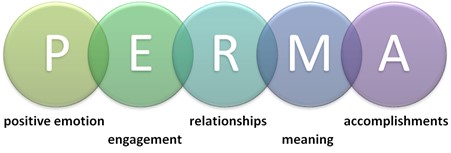Topic 6.2: Resilience and happiness at work
Sometimes we can be a little suspicious of the idea of being ‘happy’ at work. Leading US psychologist Martin Seligman has for many years been prominent in the research and communication of ideas around positive psychology, happiness, resilience, and optimism. He is a regular visitor to Australia and gives keynote addresses around ‘Subjective Well Being’ around the world. Seligman is noted for his work on ‘learned helplessness’ – a well-supported theory positing that we often collude in our own lack of power and success through self-limiting ideas and behaviours.
As an introduction to Seligman’s work, you could explore the website and explore a range of resources. The site includes a range of self-assessment tools that can help you explore the various elements of his PERMA model.
Seligman’s work is underpinned by a belief that we should…
- be more concerned with building strength than with remedial work on weakness and ‘gaps’
- be as interested in pursuing the best things in our current situation as in repairing the worst
- develop interventions to increase wellbeing and happiness at work, not just to decrease misery!
The PERMA model was developed by Seligman as a way of exploring the connected five building blocks of well-being. Each element is considered essential to leading a life in which you can flourish and find enduring happiness.

| Positive Emotion | For us to experience well-being, we need positive emotion in our lives. Any positive emotion such as peace, gratitude, satisfaction, pleasure, inspiration, hope, curiosity, or love falls into this category – and the message is that it’s really important to be open to the experience in the here and now, just as long as the other elements of PERMA are in place. |
| Engagement | When we’re truly engaged in a situation, task, or project, we experience a state of flow: time seems to stop, we lose our sense of self, and we concentrate intensely on the present. This feels good! The more we experience this type of engagement, the more likely we are to experience well-being. |
| Positive Realtionships | As humans, we are “social beings,” and good relationships are core to our well-being. Time and again, we see that people who have meaningful, positive relationships with others are more satisfied with life than those who do not. Relationships really do matter! |
| Meaning | Meaning comes from serving a cause bigger than ourselves. Whether this is a specific deity or religion, or a cause that helps humanity in some way, we all need meaning in our lives to have a sense of well-being. |
| Accomplishment/Achievement | Many of us strive to better ourselves in some way, whether we’re seeking to master a skill, achieve a valuable goal, or win in some competitive event. As such, accomplishment is another important thing that contributes to our ability to flourish. |
Required Reflection
20 min
Considering yourself, what are one or two areas of the PERMA that you would like to focus on to enhance well-being?
What are some practical examples of each of these components in a work context?
Required Reading and Reflection
30 min
- Reflect on how closely you are living your eulogy or your resume?
- Is there something you need to do to shift the emphasis a little?
- Take a few minutes to revisit your notes from Module 1 about your ‘sentence’ and try to identify ways you have been living your sentence, or have a go at drafting your sentence or ‘brand’ if you haven’t yet done so.
Recommended Activity
22 min
Deeper Learning Activity
20 min
Deeper Learning
15 mins

